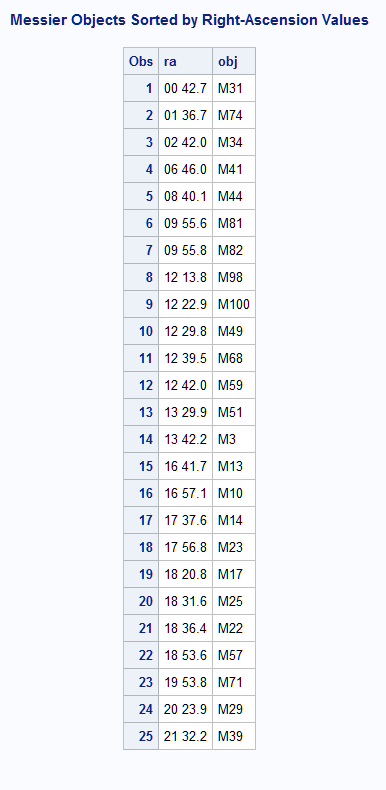OUTPUT Method
Creates one or more data sets, each of which contains the data in the hash object.
| Applies to: | Hash object |
Syntax
rc=object.OUTPUT (DATASET: 'dataset-1 <(datasetoption)> '
<, ...<DATASET: 'dataset-n>'> ('datasetoption <(datasetoption)> ');
<, ...<DATASET: 'dataset-n>'> ('datasetoption <(datasetoption)> ');
Arguments
rc
specifies whether the method succeeded or failed.
A return code of zero
indicates success; a nonzero value indicates failure. If you do not
supply a return code variable for the method call and the method fails,
then an appropriate error message is written to the log.
object
specifies the name of the hash object.
DATASET: 'dataset'
specifies the name of the output data set.
The name of the SAS
data set can be a character literal or character variable. The data
set name can also be enclosed in double quotation marks. When specifying
the name of the output data set, you can use SAS data set options
in the DATASET argument tag. Macro variables must be enclosed in double
quotation marks.
datasetoption
specifies a data set option.
For more
information about how to specify data set options, see Syntax in SAS Data Set Options: Reference.
Details
Hash object keys are
not automatically stored as part of the output data set. The keys
can be defined as data items to be included in the output data set
by using the DEFINEDATA method. In addition, if no data items are
defined using the DEFINEDATA method, the keys are written to the data
set specified in the OUTPUT method.
If you use the
ordered: 'yes' or ordered: 'ascending' argument
tag in the DECLARE statement or the _NEW_ operator when you instantiate
the hash object, then the data items are written to the data set in
ascending key-value order. If you use the ordered: 'descending' argument
tag in the DECLARE statement or the _NEW_ operator when you instantiate
the hash object, then the data items are written to the data set in
descending key-value order. If you do not use the ordered argument
tag, the order is undefined.
When specifying the
name of the output data set, you can use SAS data set options in the
DATASET argument tag. Data set options specify actions that apply
only to the SAS data set with which they appear and enable you to
complete these actions:
-
rename variables
-
select a subset of observations based on the observation number for processing
-
select observations using the WHERE option
-
drop or keep variables from a data set loaded into a hash object, or for an output data set that is specified in an OUTPUT method callNote: The variables that are dropped or kept must have been included in the hash table by using the DEFINEDATA or DEFINEKEY method. Otherwise, an error occurs.
-
specify a password for a data set
This example uses the
WHERE data set option to select specific data for the output data
set named OUT.
data x;
do i = 1 to 20;
output;
end;
run;
/* Using the WHERE option. */
data _null_;
length i 8;
dcl hash h(dataset:'x');
h.definekey(all: 'y');
h.definedone();
h.output(dataset: 'out (where =( i < 8))');
run;This example uses the RENAME data set option to
rename the variable J to K for the output data set named OUT. data x;
do i = 1 to 20;
output;
end;
run;
/* Using the RENAME option. */
data _null_;
length i j 8;
dcl hash h(dataset:'x');
h.definekey(all: 'y');
h.definedone();
h.output(dataset: 'out (rename =(i=k))');
run; For a list of data set options, see SAS Data Set Options: Reference.
Note: When you use the OUTPUT method
to create a data set, the hash object is not part of the output data
set. In this example, the H2 hash object is omitted from the output
data set and a warning is written to the SAS log.
data _null_;
length k 8;
length d $10;
declare hash h2();
declare hash h(ordered: 'y');
h.defineKey('k');
h.defineData('k', 'd', 'h2');
h.defineDone();
k = 99;
d = 'abc';
h.add();
k = 199;
d = 'def';
h.add();
h.output(dataset:'work.x');
run;Example
Using the data set ASTRO
that contains astronomical data, the following code creates a hash
object with the Messier (OBJ) objects sorted in ascending order by
their right-ascension (RA) values and uses the OUTPUT method to save
the data to a data set.
data astro;
input obj $1-4 ra $6-12 dec $14-19;
datalines;
M31 00 42.7 +41 16
M71 19 53.8 +18 47
M51 13 29.9 +47 12
M98 12 13.8 +14 54
M13 16 41.7 +36 28
M39 21 32.2 +48 26
M81 09 55.6 +69 04
M100 12 22.9 +15 49
M41 06 46.0 -20 44
M44 08 40.1 +19 59
M10 16 57.1 -04 06
M57 18 53.6 +33 02
M3 13 42.2 +28 23
M22 18 36.4 -23 54
M23 17 56.8 -19 01
M49 12 29.8 +08 00
M68 12 39.5 -26 45
M17 18 20.8 -16 11
M14 17 37.6 -03 15
M29 20 23.9 +38 32
M34 02 42.0 +42 47
M82 09 55.8 +69 41
M59 12 42.0 +11 39
M74 01 36.7 +15 47
M25 18 31.6 -19 15
;
run;
data _null_;
if _N_ = 1 then do;
length obj $10;
length ra $10;
length dec $10;
/* Read ASTRO data set as ordered */
declare hash h(hashexp: 4, dataset:"work.astro", ordered: 'yes');
/* Define variables RA and OBJ as key and data for hash object */
h.defineKey('ra');
h.defineData('ra', 'obj');
h.defineDone();
/* avoid uninitialized variable notes */
call missing(ra, obj);
end;
/* Create output data set from hash object */
rc = h.output(dataset: 'work.out');
run;
proc print data=work.out;
var ra obj;
title 'Messier Objects Sorted by Right-Ascension Values';
run;Messier Objects Sorted by Right-Ascension Values

Copyright © SAS Institute Inc. All Rights Reserved.